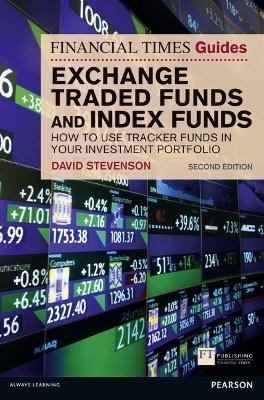
Financial Times Guide to Exchange Traded Funds and Index Funds, The
FT Publishing International (Verlag)
978-0-273-76940-8 (ISBN)
The second edition of this book attempts to answer this debate and is the indispensable bible on trackers for professional advisers and serious private investors.
This new edition also features a chapter based around the theme of Due Diligence and a new chapter on How to use ETFs and Index Funds for theLong-term, as well as a new Jargon busting section and a-new appendix looking at new ideas beginning to emerge.
David Stevensonis a columnist for the Financial Times Weekend edition and authors the Adventurous Investor section where he writes about everything from investing in Mongolia through to using ETFs in your portfolio. He’s also a columnist for the Investors Chronicle (based around his SIPP) and before that was a columnist for Citywire. David writes extensively about ETFs for the FT and has developed a series of Master Portfolios that make use of index tracking funds for the Investors Chronicle.
INTRODUCTION – By Matthew Vincent, FT
CHAPTER 1 – Investing 2.0 The Revolution Begins
· Decline of the stockpicker and now the decline of active fund manager
· Need to emphasize cost in this low return world
· Investors waking to the reality that they have to diversify especially after bear markets
· The rise of asset class investing, related to but separate from ETfs and index funds
· The rise of the dreaded term beta…
CHAPTER 2 – A BIT OF THEORY
Where it all came from academically. The academic revolt
The efficient markets theory
The fundamentalists wade in
The first ETF structures and index funds. The legendary John Bogle and the Vanguard Phenomena
CHAPTER 3 – WHAT ARE INDEX OR TRACKER FUNDS?
Index mutual funds and how they developed from these into these…
Exchange Traded funds, US Style
European ETFs – the rise of the swap
ETNs in the US and certificates in Europe
ETCs (commodities) and synthetic ETFs
The mechanics – full replication, partial replication, fully synthetic replication
Comparing ETFs vs traditional mutual funds vs index mutual funds
Advantages of different structures and the regulatory structure
New innovations – inverse ETFs, multi-ETF portfolios, actively managed ETFs
CHAPTER 4 – THE FIDDLY DETAIL….RISKS, CAVAETS and the INIDICES
What to watch out for – premiums/discounts, tax complications, tracking error, charging (some are expensive – the 1% rule)
Counter Party Risk
Why the index matters – not all indices created equally. Some are too concentrated, carry currency risks, aren’t very liquid, and some are just pointless
CHAPTER 5 – THE RISE OF THE FUNDAMENTALISTS
Guest writer – Rob Davies, fund manager of the Munro Fund, a fundamental index fund
The academic theory surrounding fundamental indexing
Does it work ? The results so far
How to implement it via a fund – black boxes, dividends and the measures used
Will it work in the future – might value investing be dead ?
CHAPTER 6 – BIG THEME INVESTING AND INDEX FUNDS
Guest Writer – Stephen Barber, Head of Research at Selftrade
Momentum investing works and particularly a focus on big themes, big structural changes
Emerging Markets
Alternative Assets
New Energy and Green markets
Infrastructure and utilities
Commodities
CHAPTER 7 – RUNNING A PORTFOLIO : SOME BASICS
Guest Writer – James Norton, Head of investment at Evolve Financial Planning
A passive portfolio – why it matters vs Active
Buy and Hold
Asset Allocation explained – correlation and diversification
Inflation
Income investing
Long Term returns ?
The GlidePath
CHAPTER 8 – ACTIVE PORTFOLIOS USING ETFS
Guest Writer – Mark Glowrey, Investors Intelligence
How to combine ETFs into an active portfolio using technical analysis
The measures sued
Running the portfolio
CHAPTER 9 – PUTTING IT ALL TOGETHER INTO A PORTFOLIO THAT WORKS FOR YOU !
Asset Class Investing
Value vs Growth vs Momentum – all work but difficult to capture these strategies
Importance of international diversification
Lazy Portfolios and why they’re so useful
The idea behind building your own MASTER PORTFOLIOS
Lifeycle Investing
Our MASTER PORTFOLIOS – the assumpti
| Reihe/Serie | The FT Guides |
|---|---|
| Verlagsort | Harlow |
| Sprache | englisch |
| Maße | 157 x 234 mm |
| Gewicht | 750 g |
| Themenwelt | Wirtschaft ► Betriebswirtschaft / Management ► Finanzierung |
| Wirtschaft ► Betriebswirtschaft / Management ► Rechnungswesen / Bilanzen | |
| Wirtschaft ► Betriebswirtschaft / Management ► Unternehmensführung / Management | |
| ISBN-10 | 0-273-76940-5 / 0273769405 |
| ISBN-13 | 978-0-273-76940-8 / 9780273769408 |
| Zustand | Neuware |
| Informationen gemäß Produktsicherheitsverordnung (GPSR) | |
| Haben Sie eine Frage zum Produkt? |
aus dem Bereich


